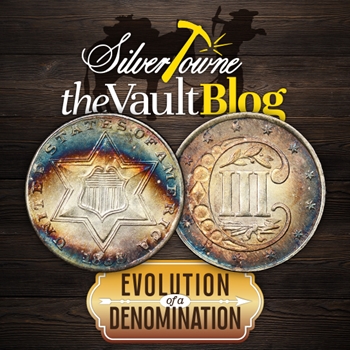
Perhaps one of the denominations of past United States coinage that strikes people funny upon hearing about them for the first time is the three-cent pieces. The smallest of U.S. coins ever struck, the idea of these coins, trimes they were called, were deemed necessary by Congress at the time. With silver coins being hoarded from circulation and the postal service prepaid rate looking to drop from five cents to three cents, the three-cent piece was born out of a need to make change in amounts less than a dollar.
Silver Three-Cent Pieces (Trimes) (1851-1873)
The hoarding of silver coinage became a problem for business persons and the public in general during the early 1850s as large copper cents and half cents were the only coins less than a dollar available to make change with. At the time, nickels were not available yet because its equivalent, the silver half dime, was among the coinage being hoarded from circulation. Because of the discovery of massive amounts of gold found out west in 1849, large supplies of gold impacted the metal’s value in relation to silver. Individuals realized that silver coins were worth more as metal than they were at face value which led to the hoarding and melting of said coins. Also in the midst of this shortage was a desire to reduce the prepaid postal rate from five cents to three cents. A three-cent piece would have been useful for this reason as well.
What was come up with was very strategic. Officials realized that producing a coin worth less than its face value intrinsically would be rejected by the public, but creating a precious metal coin comprised of 90% silver would lead to the hoarding of it as well. In the end, they decided upon a 75% silver and 25% copper alloy that would turn into a law authorized by Congress on March 3, 1851.
Designed by James B. Longacre, the first three-cent silver pieces featured a nationalistic shield upon a six-pointed star on the obverse. It was encircled by the words “UNITED STATES OF AMERICA” around the outer edge with the date at the bottom. The reverse features the value in Roman numerals (III) with a beaded ‘C’ around them. It also features thirteen stars around the outer border. This initial design was produced from 1851-1853 while a Variety 2 was produced from 1854-1858 and a Variety 3 was produced from 1859-1873. Proof versions were produced in small numbers starting in 1858.
Nickel Three-Cent Pieces (1865-1889)
Much like silver coinage before its time, three-cent pieces were being hoarded by the public. Even though alternatives were produced to prevent this from happening, it was not enough. Once again designed by James B. Longacre, these new nickel three-cent pieces were silver in color but were made of an alloy comprised of 75% copper and 25% nickel. The obverse design featured the head of Liberty facing left. The beaded coronet around her head featured the incused word “LIBERTY”. The date could be seen at the very bottom with the words “UNITED STATES OF AMERICA” were seen around the outer edge of the coin. Much like its silver counterpart, the reverse depicted the Roman numeral III in the center representing the denomination. It is surrounded by a wreath which was adapted from the wreath used on the cent from 1859. Over 11 million coins were struck in its first year of 1865. Proof strikes were produced in small numbers every year.
In its final year of production, the need for a three-cent piece was all but dead. Postal rates changed and the idea of the denomination was never seen as a lasting need in the United States coinage system. It was finally discontinued by the Act of September 26, 1890.
Source: The Official 2021 Red Book; NGCCoin.com







